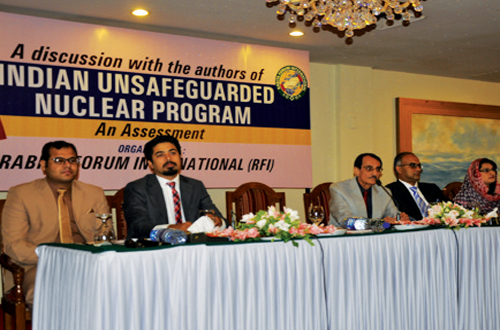On Thursday, 24th November, 2016, at “Hotel Pearl Continental”, Karachi.
SPEAKERS
1. Mr. Nusrat Mirza 2. Syed Muhammad Ali 3. Ambassador . Ali Sarwar Naqvi 4. Ms. Adeela Azam 5. Mr. Ahmad Khan 6. Mr. Sameer Ali Khan
1. A book titled ‘Indian Unsafeguarded Nuclear Program’, published by the Institute of Strategic Studies, Islamabad (ISSI) and coauthored by Adeela Azam, Ahmad Khan, Syed Mohammad Ali and Sameer Ali Khan, unveils a new and comprehensive assessment of the Indian nuclear weapon making capacity. The findings of this book are based on the detail review of official Indian documents, books, research articles, and statements leading international and Indian nuclear scientist.
2. This study unveils the size and capabilities of the four aspects of Indian nuclear program, which are uranium reservoirs, uranium enrichment, nuclear reactors and processing. The book highlights that Indian nuclear program is the largest and oldest unsafeguarded nuclear program in the entire developing world and among non-NPT States.
3. In her detail assessment on uranium reservoirs in India, Adeela Azam has argued that India’s own mines have sufficient uranium reserves and capacity to run New Delhi’s existing reactors for more than a century. India has produced nuclear fuel beyond the current requirements of its Pressurized heavy Water Reactors.
4. Ahmad Khan gives his assessment on the Indian enrichment capacity which suggests the India uranium enrichment program is perhaps the fastest growing in the world and provides New Delhi with ample uranium enrichment capacity, to not only run its large future fleet of nuclear powered ballistic missile submarines but also to build nuclear and thermonuclear weapons.
5. Syed Muhammd Ali in his chapter on unsafeguarded nuclear reactors in India discusses a new assessment of how many nuclear bombs India can actually make, based on the removal of weapon-grade and reactor-grade plutonium from its nuclear reactors, kept outside IAEA safeguards. He opines that the current unsafeguarded nuclear reactor capacity of India can allow it to develop up to 356 to 492 plutonium-based nuclear weapons.
6. Sameer ali Khan stressed that New Delhi’s large reactor-grade plutonium stockpile is weapon-useable and it has kept almost its entire know reprocessing capacity outside IAEA safeguards, which is available for military use. In addition, India is keeping its Fast Breeder reactor program outside the IAEA safeguard for potential military use. Operating at eighty percent of their know capacities, Indian reprocessing plants could have separated more than one ton of weapons-grade plutonium, sufficient for approximately 196 to 294 nuclear warheads. Moreover, India might have separated over 9 to 12 tons of additional reactor grade plutonium.
7. Alternatively, assuming a more conservative efficiency f the Indian reprocessing plants of fifty percent capacity, New Delhi could have separated over 700 kgs of weapon-grade plutonium, sufficient for building 126 to 189 nuclear weapons besides separating over 5 to 7 tons of reactors grade plutonium. This additional 5 to 12 tons stock of reactor-grade plutonium is potentially weapon usable and, if not used in Fast Breeder Reactors, could support an additional arsenal of 833 to 3000 reactor-grade plutonium based nuclear weapons besides those based on weapons grade plutonium. Even if this unsafeguarded reactor grade plutonium stocks are used to fuel Indian FBRs, the ultimate output (weapons grade plutonium) will find its only utility in nuclear weapons. This estimate does not mean that the estimates presented in earlier chapters are inconsistent with these estimates or incorrect. The difference in these estimates is because each chapter has looked at the capacities of Indian nuclear facilities rather than actual production.


